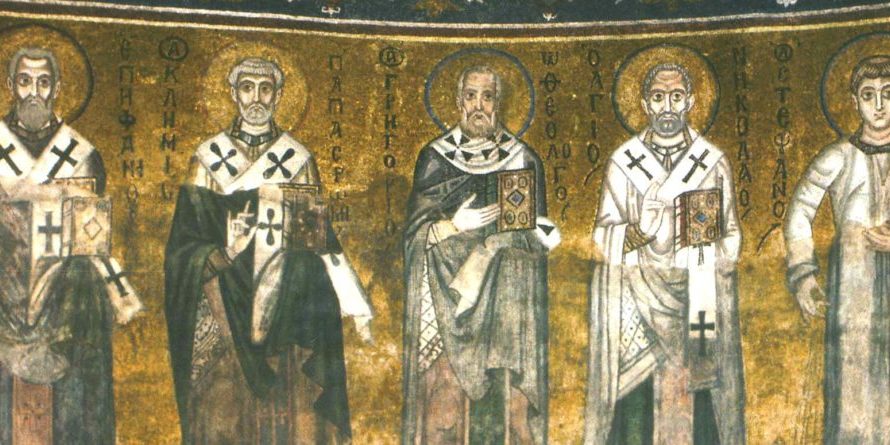
Trinitarian Language in the Early Church
The doctrine of the Trinity is the fundamental doctrine of orthodox Christianity. I admit, that phrase may sound controversial to some. Many people understandably wonder about the origins of the doctrine of the Trinity—after all, the word “Trinity” is not found in Scripture. Indeed, some churches argue that the Trinity is just a philosophical doctrine that developed long after the Bible was written; therefore, it is at worst an unbiblical teaching and at best a secondary issue Christians can reasonably disagree on.
To defend the bold claim in the first sentence of this article, it is important to understand two basic claims. First, the doctrine of the Trinity is a non-negotiable doctrine based on the biblical data. The early church understood this and continued to appeal to Scripture as their defense for the doctrine. Second and because of that, the Trinity is not a doctrine invented by the early church, but rather a doctrine that is necessarily derived from reading Scripture.
As we will see, the way to understand Trinitarian theology biblically and historically is to understand the stages of Trinitarian language between the biblical writings and the formation of the orthodox Christian creeds. Indeed, Trinitarianism did not fall from the sky, nor did Jesus write the Nicene Creed on tablets and hand it to the apostles after his resurrection. Instead, the terminology changed over time for various contextual and missional reasons, particularly in response to the issues listed below. The biblical writers did not use the same terms as the Nicene Creed to describe the nature and relations of the Father, Son, and Holy Spirit, but they all affirmed Trinity at some level. Perhaps an illustration will help drive home this point. The Trinity is not a doctrine invented by the early church, but rather a doctrine that is necessarily derived from reading Scripture. Click To Tweet
When describing the moon, my young daughter, an astrophysicist, and myself would describe the moon in different ways. My daughter may note that the moon is a round object on the other side of the clouds; I may describe the moon as a ball of rock that is beyond our atmosphere but orbits the earth via gravitational pull; an astrophysicist may explain that the moon is made up of mafic and anorthosite rocks, as well as speaking of the synchronous rotation of the Earth and moon. While the astrophysicist may use more terminologically-advanced language than my daughter or myself, she is ultimately describing the same object that all three of us can fundamentally observe and identify. One would not accuse my daughter of not knowing what the moon is, regardless of the terms she employs. In the same way, the biblical and pre-Nicene writers understood that God is triune, but with varying levels of conceptual clarity or terminological sophistication.
Major Issues in Developing Trinitarian Language
Several issues arose in the early church with respect to the biblical teaching about Jesus and the Holy Spirit. As these issues arose, the early church never left biblical truth, but at times needed to either use or develop different terminology to respond to contextual or missional concerns.
- Interpretation of biblical texts. The primary reason for the development of Trinitarian language can be found in the earliest debates about the Bible’s witness to the nature and activities of Christ and the Holy Spirit. The famous battle between the camps of Athanasius and Arius over the nature of the Son, for example, was not merely over terminology, but fundamentally over the interpretation and theological summations of biblical texts. Athanasius was not being pedantic about theological jargon; rather, he noted, for instance, that we cannot rightly worship Christ as Scripture demands unless Christ is truly God.[1] Put another way, the development of the doctrine of the Trinity was not just a philosophical or academic argument, but an argument rooted in understanding the Bible and teaching it rightly.
- Response to false teaching. As the gospel spread and the Bible was copied and shared, obviously a wide array of interpretations took form. As these interpretations gained steam, the bishops and church leaders began fighting against heresies that went against biblical teaching and the “rule of faith,” which was a summary of right theological positions. So sometimes the earliest Christians didn’t know what theological language to correct until they saw bad versions of it. This explains, at least in part, why Athanasius and others used the term homoousios (“same substance”) to defend that the Son is not inferior to the Father. This is not a biblical term, per se, but was a contextual term in the fourth-century that made the same judgment as Paul’s language when he says that Jesus is “equal with God” or has “the name above all names.”[2]
- The definition of “divine.” Another major issue revolved around the definition of “divine.” In Jewish and Greco-Roman world, there were plenty of stories and religious myths that included kings becoming gods, angels and mediator figures, a hierarchy of gods, etc. Remembering that the earliest Christians were almost entirely Jewish, they had to reckon with the fact that Jesus and the Holy Spirit were both acting and being described in ways that potentially rivaled the identity of YHWH. So to be a monotheistic Jew in the first century who took Jesus and the Holy Spirit seriously, one had to, in some ways, reimagine what it meant to confess the Shema in Deuteronomy 6: “Hear, O Israel, the Lord our God is one.” The biblical authors do this in various ways—as we will cite below—so even with the New Testament, terminology and interpretive skill was developed to describe the Father, Son, and Spirit.
- Clarifying ontology (nature) and economy (function). How do we explain the fact that we believe that God is one, as the Shema says, while also acknowledging and believing, for example, that Jesus is truly divine and worthy of worship? This is where the church began to develop language that would not deny monotheism, but could also include Jesus and the Spirit in the identity of YHWH. While the terms “ontology” and “economy” are not biblical words, they were used by later theologians to make sense of the tension between the unity of God (one God) and the three persons (Father, Son, and Spirit). While the terms “ontology” and “economy” are not biblical words, they were used by later theologians to make sense of the tension between the unity of God (one God) and the three persons (Father, Son, and Spirit). Click To Tweet
To explain the development, I tend to use these terms: incipient (the beginning of development); proto- (a precursor); and the final form we have in the creeds of Nicaea and Constantinople.
The Development of Trinitarian Language
- Incipient Trinitarianism (ca. AD 30-96). This stage of Trinitarianism happened between the resurrection of Jesus and the end of the writings of the biblical canon. In the case of John or Paul, for example, the language for the Trinitarian persons is not systematized or always terminologically consistent. However, the biblical writers clearly understood that their view of monotheism needed to be reimagined—but not abandoned—in light of Jesus’s resurrection and the sending of the Holy Spirit. This can be seen in biblical authors’ tying Jesus and the Spirit to the identity of YHWH in the OT through titles, exegesis of passages, doxologies, and logical explanations. See, for example, Matthew 1-3; Mark 3:28-30; John 1:1-14; John 5:17-23; 1 Cor 8:6; Col. 1:15-20; 1 Pet 1:2; Rev 1:4-18.
- Proto-Trinitarianism (ca. AD 96-325). This stage of Trinitarianism refers to the post-biblical era which stood as a precursor to the Nicene/Nicene-Constantinopolitan creeds. This type of Trinitarianism begins to deal with the ingredients provided by biblical-canonical data. Similar to Incipient Trinitarianism, this is not a fully systematized doctrine of the Trinity in the ways later creedal formulations would articulate, but the writers in the period began to grapple with the philosophical ideas of ontology and economy in God’s being. For example, Irenaeus and Origen’s theologies have hints of the creedal Trinitarianism listed below, but they’re not especially precise in how God is both one in essence and three in personhood.
- Pro-Nicene Trinitarianism (ca. AD 325-381). This stage of Trinitarianism is the fully systematized, orthodox version that we confess today. Given the development and diversity of early Christian theologies of the Father, Son, and Spirit, these councils/creeds gave precise language to the biblical data in a way that preserved orthodoxy for the future of the church and weeded out the biblical and philosophical hoop-jumping of early heretics. The passages mentioned above were some of the most important passages for their formulations.
In this brief survey, we see that the Trinity is certainly biblical and that the early church built their Trinitarian theology on Scripture. The issues noted above help explain why Trinitarian theology went from in some sense assumed by early Christians to needing precise language preserved in creedal form. While space does not permit us to exegete all the passages listed above, that is a swath of data worth pondering, just as the early church did.
Endnotes
[1] Athanasius, Apologia Contra Arianos (Discourses Against the Arians), 2.20.
[2] This comparison is owed to David S. Yeago, “The New Testament and the Nicene Dogma,” Pro Ecclesia 3 (1994): 160–61. More on this below.

